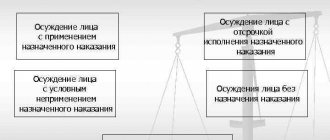Murder, regardless of motive (intentional or reckless), is considered a criminal offense. Deprivation of life due to negligence is qualified under Art. 109 of the Criminal Code (CC) of the Russian Federation. The penalty for manslaughter is imposed on any guilty citizen who has reached the age of 16.
It is very difficult to prove that a crime was committed through negligence. Judges often assume that the attacker wanted to take the life of the victim. Collecting evidence and witness statements is painstaking work that requires concentration and a fair amount of courage.
A criminal who has killed a person through negligence, as well as members of his family, are often in a state of panic or depression. It is difficult for them to independently analyze the facts and build a defense in court. To increase the chances of a favorable outcome of the trial, it is better to seek the help of a lawyer.
Do you want to figure it out, but don’t have time to read the article? Lawyers will help
Entrust the task to professionals. Lawyers will complete the order at the cost you specify
27 lawyers on RTIGER.com can help with this issue
Solve the issue >
Decoding the concept
The very concept of murder should not be considered in terms of “intentionality” or “unintentionality.” It already contains the factor of guilt, since “murder” implies a deliberate action aimed at achieving the result - the death of the victim.
For a crime to be considered manslaughter, the following circumstances must be present:
- Lack of motive;
- The killer did not want such consequences to occur;
- Absence of intent to commit murder;
- Having strong remorse.
An act takes on the meaning of “unintentional” when it happened without the will and intention of the person involved. Positioning the person whose fault it happened as a murderer is incorrect. And in the legislation of the Russian Federation there is a term for it “causing death by negligence.” This concept unites similar crimes in Article 109 of the Criminal Code of the Russian Federation precisely on the basis of the absence of a direct plan and the attempted murder of one person by another.
Evidence base
In the Russian Federation, Article 73 of the Criminal Procedure Code defines what the evidence base is. In a criminal case, the following circumstances are proven:
- place and time of death of a person;
- killer's motives;
- the size and nature of the damage caused;
- aggravating and mitigating circumstances;
- the presence of reasons that may provide grounds for exemption from punishment.
Evidence under Article 109 of the Criminal Code is any circumstances in the case on the basis of which it is established whether the accused is guilty or not.
5 types of evidence:
- testimony of the suspect and accused;
- witness statements;
- opinions of experts and specialists;
- evidence. These include equipment and facilities that have retained traces of a criminal act. Items that can serve to restore the circumstances of the case are also material evidence;
- protocols of investigative activities.
According to Art. 75 of the Criminal Procedure Code, all evidence must be obtained in accordance with the requirements of procedural law. This means that you cannot trust the words of witnesses if their assumptions are based on hearsay or they cannot say the source of their knowledge. The statute of limitations is two years.
Circumstances leading to the tragedy
The history of criminology knows many examples when a person’s life was cut short not as a result of hostilities or a planned assassination attempt, but by coincidence.
- As a result of a domestic conflict.
Most often this happens among citizens leading an antisocial lifestyle, while drinking alcohol or being under the influence of drugs.
- In the course of improper performance of their guardianship duties.
This group includes all cases of leaving a child without parental care, an elderly person or a person with mental disabilities - without the supervision and assistance of a guardian.
- In case of improper performance of professional duties.
As a rule, tragedies occur in a medical institution (negligence of medical staff leading to the death of a patient) and at work. At enterprises this is possible: a) if management has violated the safety standards of its employees; b) if the specialist performed his duties negligently, which led to the death of his workmate.
- As a result of the use of uncertified gas or electrical equipment connected to a citizen’s home or garage.
The person who sold and connected such equipment could not have been unaware of the danger it poses to the owner.
- Neglect of driving rules, aggravated by the use of alcohol or drugs.
Especially when it comes to representatives of professions on which the lives of others depend: doctors, drivers, etc.
- As a result of exceeding permissible self-defense.
A citizen is not able to adequately assess the danger threatening him or his loved ones. He makes efforts and means to protect himself, leading to death in a situation of attack or penetration into the suspect’s home.
- Being in a state of passion.
The person involved performs the actions that led to the death of a person in an altered consciousness, under the influence of information or a situation that caused severe stress and the inability to control his actions. Having come to a calm state, the citizen realizes what happened and tries to help the victim. But at the very moment of the crime, he obviously cannot predict the consequences of his actions.
At the same time, it must be stipulated that violation of safety rules at the enterprise by the employee himself, which led to his death, is not imputed to the manager (if these rules and safety instructions were promptly brought to the attention of the employee, about which his signature is present).
These are the main factors leading to tragedy. However, there are many others that are not so often encountered in forensic practice. Each case is individual and contains both obvious and hidden aspects.
Signs of intent to commit murder or lack thereof
The commission of a deliberate act is always indicated by the motive for committing a crime that resulted in death.
The main difference between manslaughter and murder is the lack of motive of the offender and the commission of actions aimed at causing death.
We are obviously dealing with murder if the criminal has:
- A relationship with the deceased that involves conflicting personal or professional interests.
- The interest of one person in the death of another (here we can consider the presence of direct or indirect intent).
- Proven actions aimed at taking the life of another person.
The definition of manslaughter is characterized by:
- Lack of any interest in the death of the victim.
- The presence of a situation of self-defense or passion.
- There is criminal negligence, neglect of one’s duties against the background of the character traits or habits of both the deceased and the suspect in his death.
- The presence of a mental illness in the person who caused death through negligence (if he was not aware of his actions).
What are the situations?
The most common of these crimes are:
- road accidents when a vehicle malfunction or driver error leads to the death of one or more persons (this does not apply to gross traffic violations);
- domestic incidents when people commit rash acts that are potentially dangerous to someone (for example, throwing a heavy object out of a window, equipping a home with unauthorized gas and electrical appliances).
Important! Also, situations that resulted in death due to negligence include some street fights, etc.
Presence or absence of signs of guilt
A dry definition says: if one person did not intend to take the life of another, did not plan this, then both of them are simply victims of circumstances.
But the absence of intent does not mean the absence of guilt. Behind each case, with rare exceptions, are the actions (or inactions) of specific people that led to the tragedy. For example, if we are talking about the occurrence of death in the presence of a person who had the opportunity and should have made at least an attempt to save someone else’s life.
To determine the extent of a person’s guilt, it is necessary to understand whether there is a relationship of cause and effect between his actions and the death of another person.
The legislation separates the concept of “causing death by negligence” from “accidental death”. In the first case, guilt is considered, in the second - no, and no punishment is provided for it.
The first option is considered in the context of how the criminal himself perceives his actions.
- The man could have foreseen the final tragic consequences of his actions, but showed criminal negligence. Then he took all the measures that depended on him to ensure that the person did not die. However, death occurred contrary to his wishes and rescue measures.
Example. The driver exceeded the speed limit and got behind the wheel of the car while intoxicated. As a result, he hit a pedestrian in the pedestrian crossing area. Realizing his guilt, he did everything in his power to prevent the person’s death: he called an ambulance and provided first aid. However, the man died. The driver's fault is obvious.
Have a question for a lawyer? Ask now, call and get a free consultation from leading lawyers in your city. We will answer your questions quickly and try to help with your specific case.
Telephone in Moscow and the Moscow region: +7
Phone in St. Petersburg and Leningrad region: +7
Free hotline throughout Russia: 8 (800) 301-39-20
Example. The mother, while preparing food in the kitchen, did not notice the child playing dangerously close to a pot of boiling water. Taking this pan, she touches the child and throws boiling water on him. As a result of the burns, the baby dies. It would seem an accidental death. However, the mother could have foreseen the danger and prevented the situation that led to the death of the child.
- The person did not foresee and could not try to prevent the death of the victim. This situation is classified as “accidental death.”
Example. The driver of a vehicle, observing all traffic rules and being sober, hits a pedestrian who has jumped onto the roadway in the wrong place. Fatal accident. However, it is not the driver's fault. He could not foresee and prevent the tragedy.
Example. During the installation of a plastic window at a high altitude, contrary to safety regulations, the installer did not tie himself down with safety equipment, and as a result fell down and died. The manager could not foresee and prevent the installer from neglecting his own safety rules and the occurrence of his death.
Object and subject of the crime (who wins whom)
The object of the offense is considered to be social relations, the purpose of which is to ensure human safety. For a crime to be considered objectively, there must be evidence that the death of the victim is a direct result of the negligent actions of the accused. This part of the qualifying features of a particular crime distinguishes the type of crime and distinguishes it from other types (for example, from Articles 115-119 of the Criminal Code).
The subject (who is being tried) of a crime can be a person who has reached the age of 16. If we are talking about death due to violation of official duties, then the subject of the crime is considered to be a person carrying out professional activities in accordance with his work (job description) - the so-called special subject.
Qualifying (aggravating) features
The legislation also evaluates the circumstances of the commission of a crime differently.
Manslaughter carries elements of qualification if:
- The death occurred as a result of criminal neglect of duty. In this case, the performer obviously knew the consequences of his actions (or, conversely, lack of reaction) and could prevent them.
- The crime resulted in the death of two or more citizens. As a rule, such consequences are also the result of frivolity and do not bear signs of an innocent deprivation of life.
Free, 24-hour consultation with legal experts on our website!
Main conclusions
- If an individual did not want to kill a person and did not foresee such an outcome, then the murder is considered unintentional.
- Criminal liability is provided for murder by negligence on the basis of Article 109 of the Criminal Code.
- The second paragraph 109 of the article is devoted to unintentional murders that occurred due to the dishonest performance by the criminal of his professional duties.
- The third paragraph 109 of the act regulates the types of punishments for group murders that happened unintentionally.
- The punishments imposed range from correctional labor to imprisonment.
- An example of a crime of negligence is the death of a patient as a result of the actions of a doctor performed during treatment.
Difficulty of investigating negligent homicide
Investigative actions begin with identifying the deceased and the person suspected of causing the death.
Next, a complete picture of the crime is compiled.
The presence or absence of a connection between the persons involved in the case is established, as well as the motives for committing the crime. This is done to determine whether the act was criminal in nature. That is, whether it was murder in the legislative sense of the meaning of this definition or bore the features of manslaughter. In the second case, death was the result of a number of circumstances not related to the intent and intent of the defendant.
If it turns out that a “careless” crime has been committed, the presence of qualifying factors is determined.
The investigation establishes the presence of a motive for the person through whose fault the death occurred. This question is key to the investigation. Sometimes the motive does not lie on the surface and is not necessarily of a financial or other obvious nature.
The presence of motive implies intent, which may be direct or indirect. That is, under certain circumstances, the further development of events depends on the person. He may clearly understand that failure to provide assistance to the victim can lead to death, but he treats this with indifference. At the trial, he himself explains his inaction by “misunderstanding” and “unwillingness” of such consequences, but the indirect desire to cause death is obvious.
The fine line separating such behavior from a real lack of understanding of the consequences of one’s actions is what the investigator identifies.
Manslaughter means that a person could not have predicted the events that led to the death of another person.
The presence of indirect intent is indicated by an understanding of the consequences of certain actions or inactions. That is, a person foresees the possibility of death coming soon, but does nothing to prevent it.
As a rule, it turns out that a person who does not suffer from cretinism or other mental disorders is still able to assess the danger and possible consequences of his actions.
But crimes committed by persons with mental disorders nevertheless have a very large share in the entire mass of such crimes.
Penalties for manslaughter
! Legal consequences for causing death by negligence occur after a citizen reaches 16 years of age.
The court first of all determines whether there was direct intent to commit murder or not. That is, it directly differentiates murder from causing death by negligence. To do this, all connections, possible motives, factors that speak of preparation are identified - in a word, desires associated with the possibility of causing death to a person.
If such motives are not identified, the circumstances are examined directly and conclusions are drawn about the presence or absence of indirect motives in the actions of the suspect.
The identity of the accused, age and presence of mental disorders, and aggravating circumstances of the crime are taken into account.
After this, a decision is made to punish or acquit the accused of causing reckless homicide.
In a normal situation, without aggravating symptoms, the court imposes correctional labor, restriction of freedom or imprisonment for up to 2 years.
If a person died as a result of the accused neglecting to fulfill his duties, then the punishment is reduced to imprisonment or restriction of freedom for up to 3 years.
For other qualifications, that is, the death of two or more persons, the punishment is up to 5 years in prison.
In case of crimes that bear characteristics of qualification, the guilty citizen is prohibited from engaging in certain professional or managerial work for a period determined by the court.
Qualification of the crime
To bring a person to justice, his guilt must be fully proven, and his actions must be classified and qualified in a certain way. A prerequisite for bringing charges is the establishment of a cause-and-effect relationship between the action of the accused and the death of the victim.
There are two types of guilt:
- due to frivolous actions, when a person realized that his dangerous actions could lead to the death of a second person, but neglected the danger and did not take the necessary safety measures (indirect intent);
- due to the negligent actions of a person who did not realize that his actions could be dangerous, although he could have foreseen their consequences.
If a person violates safety rules, neglects discipline, precautions when performing potentially dangerous activities, does not comply with generally binding rules, and his actions cause the death of someone, then liability for causing death occurs.
If failure to comply with official and professional duties or the negligence of the perpetrator causes the death of two or more persons, then an increased degree of liability is provided.
Complaint to the Supreme Court
The Supreme Court of the Russian Federation is the last instance for appealing a verdict passed by a court of first and second instance. A supervisory appeal can be filed after the verdict has entered into legal force, but no later than a month. It contains all the information about the persons involved in the case, the lower courts, their decisions, a request to review the case or to send it for further investigation.
Please note that Russian legislation is constantly changing and the information we write may become outdated. In order to resolve the issue you have regarding Criminal Law, we advise you to seek the advice of a lawyer in support of the site. To do this, use the form below or contact the specialist directly on the right side of the screen.





